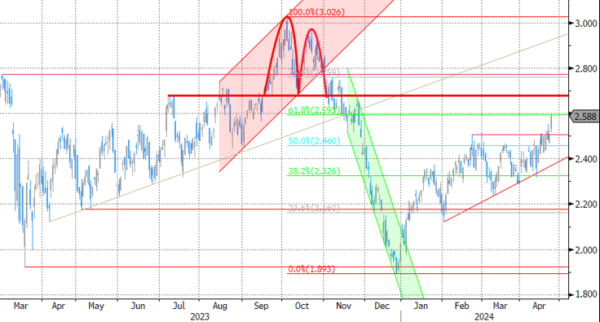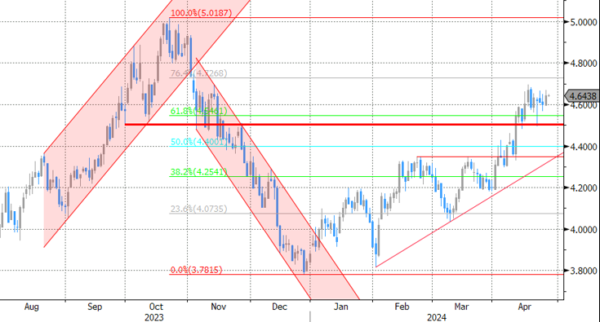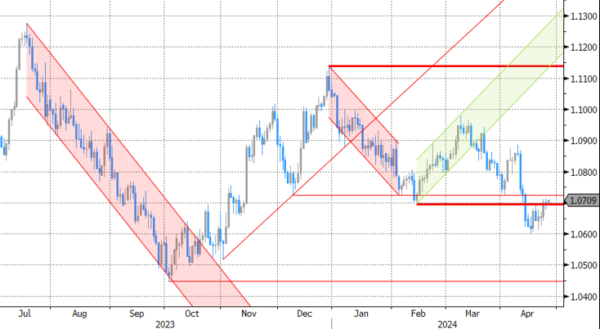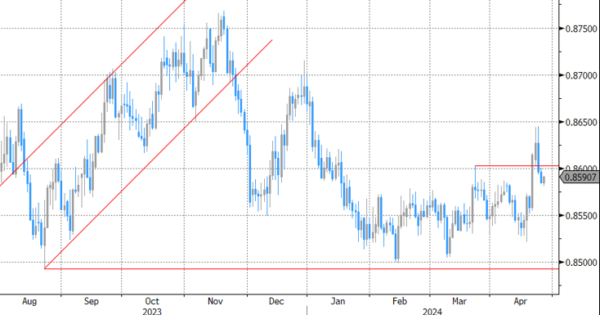Markets
US yields reached new YTD highs across the curve following Q1 US GDP data. The 1.6% Q/Qa headline print missed consensus by quite a margin (2.5% Q/Qa), but details showed underlying strength in consumption and investments. The biggest drag came from net exports with imports rising faster than exports, which we consider a sign of resilient demand. Inventories also weighed on growth in another hint of firm domestic demand. Final sales to domestic purchasers grew at a much stronger 2.8% pace. Higher spending on services was partly offset by a decrease in goods. Quarterly PCE price gauges flanked the GDP number with the core PCE accelerating more than expected, from 2% Q/Qa to 3.7% Q/Qa and matching the fastest pace since Q1 of last year. The PCE figures strengthen the view coming from CPI reports that inflation is reaccelerating away from the (never-reached) 2% inflation target. They warrant the current higher for longer market positioning which we expect to be cemented at next week’s FOMC meeting. Another very low weekly jobless claims figure and stronger pending home sales offered US Treasuries no way back. Daily changes on the US yield curve ranged between +4.1 bps (30-yr) and +7.1 bps (2-yr) yesterday. The 2-yr yield closed at 4.9975%. We stick to the view that it will take anticipation on rate hikes instead of cuts to push this tenor above this psychologic mark. Therefore we think that the long end of the curve remains most vulnerable. German Bunds followed US Treasuries south in the aftermath of the GDP/PCE. German yields rose by 2.8 bps (30-yr) to 5.2 bps (3-yr). The German 2-yr yield closed above 3% for the first time since November of last year. The 10-yr yield broke through 2.6% resistance (62% retracement on Q4 decline) giving the technical thumbs up for a full return to last year’s 3.02% high. Market correlation between Fed delaying rate cuts and the ECB holding rates after a flagged 25 bps cut in June is high. Especially since latest European confidence indicators hint at green shoots following last year’s standstill. The dollar clawed back immediately after the data (EUR/USD 1.0720 to 1.0680) but failed to hold on to these gains with the pair eventually closing at 1.0725. Stock markets offer part of the explanation with Nasdaq for example able to limit an opening loss of 2.25% (!) to only 0.5% in the close. Today’s eco calendar contains US income and spending data and March PCE deflators. Those shouldn’t come as a surprise after yesterday. We expect bonds to remain under pressure going into a data-heavy week with EMU CPI’s, US ISM’s, ADP, payrolls and FOMC meeting.
News & Views
The Bank of Japan kept its target policy rate unchanged at 0-0.1% and will continue to buy bonds in line with the guidance it gave in March. In its quarterly economic update, the BoJ projects inflation (CPI ex. fresh food) in the range of 2.5-3% for fiscal 2024 and at around 2% for fiscal 2025 and 2026. Underlying CPI inflation is expected to increase gradually, since it is projected that the output gap will improve and as medium- to long-term inflation expectations will rise with a virtuous cycle between wages and prices continuing to intensify. This will keep inflation at a level consistent with the inflation target also in the later part of the projection period. The BoJ didn’t give any concrete guidance on the time for further rate hikes but governor Ueda still gives a press conference later today. The lack of policy engagements this morning results in a further decline of the yen with USD/JPY touching a new 34-year top north of USD/JPY 156. Markets are now again looking at the Ministry of Finance for potential interventions to stop a too fast decline of the currency. Aside from the BoJ meeting, Tokyo April CPI data decelerated sharply (ex fresh food from 2.4% from 1.6%). However, the data were distorted due to the start of education subsidies, which also makes the link less tight with the national data that will be published later.
UK consumer confidence (GfK) improved further in April from -21 to -19, matching the best level since early 2022.. Consumers are turning more confident on their personal finances, on the economic situation (last and next 12 months) and climate for major purchases. The improvement was supported by “the impact on household budgets of lower inflation and the anticipation of further tax cuts”. It is in line with other recent survey evidence, also from the corporate sector, that the UK is likely moving toward better growth going forward.
Graphs
GE 10y yield
ECB President Lagarde clearly hinted at a summer (June?) rate cut and seems to have broad backing. EMU disinflation will continue in April and bring headline CPI (temporary) at/below the 2% target. Together with weak growth momentum, this gives backing to deliver a first 25 bps rate cut. A more bumpy inflation path in H2 2024 and the Fed’s higher for longer strategy make follow-up moves difficult. Markets come to terms with that, pushing yields up.
US 10y yield
The March dot plot contained several hawkish elements including a symbolically higher neutral rate. In our view they set the stage for a later (September at the earliest, likely December) start of a possibly shallower cutting cycle. Upcoming CPI readings (through base effects) and resilient eco data should confirm this. US yields continue their uptrend across the maturity spectrum, setting fresh YTD highs.
EUR/USD
Economic divergence (US > EMU) and a likely desynchronized rate cut cycle with the ECB exceptionally taking the lead pulled EUR/USD towards the YTD low at 1.0695. Stronger-than-expected US March inflation figures forced a technical break, opening the path to last year’s low at 1.0494.
EUR/GBP
Debate at the Bank of England is focused at the timing of rate cuts. Most BoE members align with the ECB rather than with Fed view, suggesting that the disinflation process provides a window of opportunity to make policy less restrictive (in the near term). Sterling’s downside turned more vulnerable with the topside of the sideways EUR/GBP 0.8493 – 0.8768 trading range serving as the first real technical reference.
















